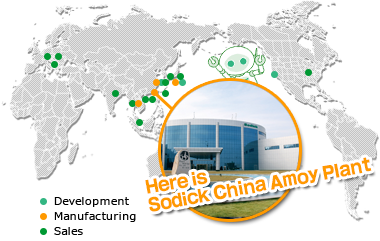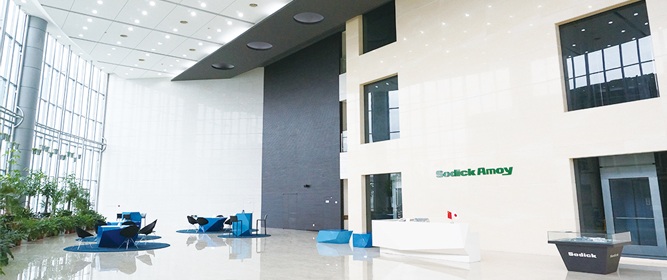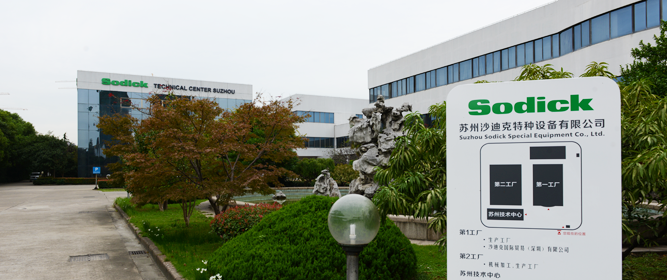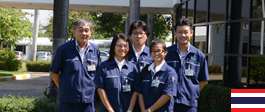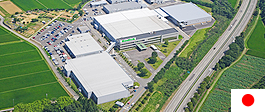Development & Production LocationSodick China Amoy Plant
Actively promoting paperless systems for top-level product quality and productivity in factories
~Building a system to motivate local staff~
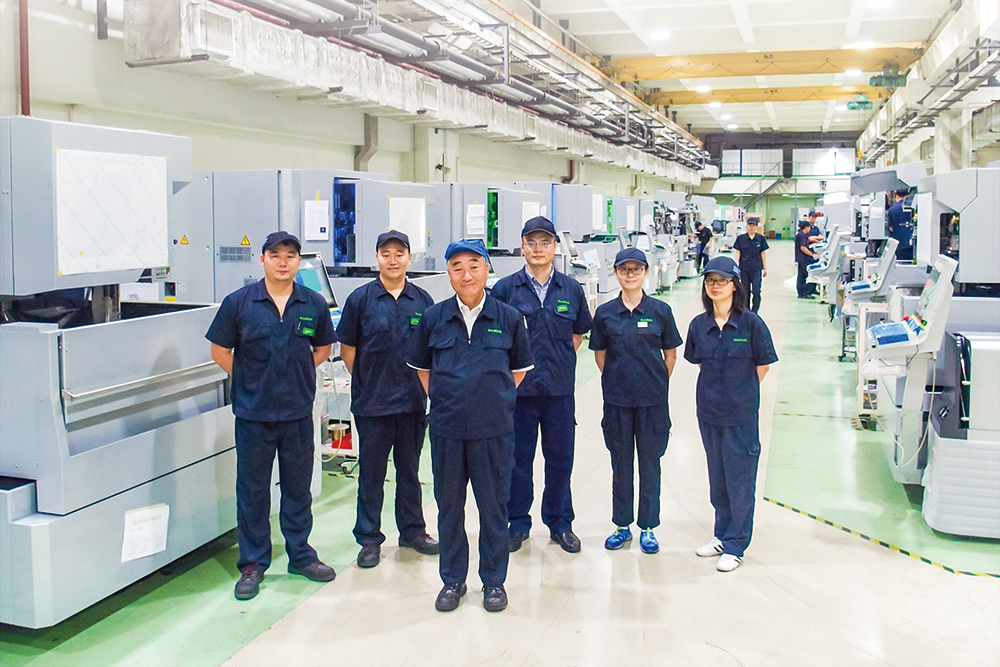
Sodick opened its Amoy Plant in 2007 with the aim of reaching No. 1 in share of electrical discharge machines in the Chinese market. As the company’s newest production base, we aim for a factory that is "Unsurpassed in the areas of product quality and productivity" (General Manager Takashi Tsuchiya) through advanced initiatives in paperless systems and the introduction of automation equipment.
11 years after the start, we have established Japanese-style improvement activities and the company's unique QVP+ activities, and improvement proposals have come up one after the other from the Chinese staff. As the need for high-precision electrical discharge machines increases within China, we are working out policies to further evolve our factories.

Profile
Address
No.376, West Yangguang Road, Haicang District, Xiamen, Fujian Province, 361022, P.R. China
Founded
April 2006
Land size
58,000 m2
Production item
・Wire-cut EDM
・Die-sinker EDM
・Linear Motors
・Noodle Making Machine

Amoy Introduction
Amoy City, where the Amoy factory is located in the southern part of Fujian Provence, features a warm climate. Along with Shenzhen, Zhuhai and Swatow in Guangdong Province, it is one of the four fastest-established special economic zones in China, and has been actively attracting foreign capital.
Well-known as a resort spot and tourist attraction, the city’s Colons Island (Gulangyu), which was registered as a World Heritage Site in 2017, has become a popular tourist attraction with its history of foreign settlements dating back to the mid-19th century and it beautiful Western-style townscape.
The Amoy Plant Manufacturing Product Lineup
 |
 |
 |
| Linear Motor Drive High Speed & High Performance ALN400G |
Linear Motor Drive High Speed & High Performance ALN600G |
Linear Motor Drive High Speed Wire-cut EDM VL400Q |
|---|---|---|
 |
 |
 |
| In-house developed and manufactured Linear motor |
In-house developed and manufactured Ceramics |
In-house developed and manufactured NC equipment |
Constructing a system that can promise consistent production from parts processing to assembly and coating
Both factories in China are mainly targeted towards customers in China, but are divided based on the models produced, such as wirecut EDM at the Amoy Plant and die-sinker EDM at the Suzhou factory. The main products of the Amoy Plant are standard type wirecut EDM "ALN400" and "ALN600." They are respectively of the G-type where processing tanks move automatically and the Q-type that is the manual movement type. In addition to these four major models, the plant also produces the reasonably priced "VL series." The production capacity is approximately 1,500 units per year. As of November 13, 2018, 650 people are employed, including 17 Japanese.
A major feature of the Amoy Plant is that it produces almost all of the key parts such as the casting parts that form the base of electrical discharge machines, sheet metal parts that cover machine exteriors, linear motors, discharge power supplies and printed circuit boards, and can consistently handle everything from assembly to coating. However, it has not been possible to always provide a steady supply of highprecision wire-cut EDM from the time of launch. Back in the early days when the Chinese staff had no experience in machine manufacturing, "we manufactured relatively simple die-sinker EDMs and gradually improved the technology" (General Manager Tsuchiya). It took about five years to build this system under the leadership of the staff at the Thailand and Suzhou factories, who already had the know-how.
Currently, the Amoy Plant has built two factories on a site of 58,000 m2; the first factory performs machine processing, sheet metal processing, assembly and coating of parts, while the second factory manufactures linear motors and the magnetic parts which form their materials. A roof is set up between the two factories, and the space beneath the roof is used as a truck yard for finished machinery. At the machine manufacturing site, in addition to 4 gate-type 5-sided processing machines, there are over 40 machines such as a 5-axis controlled vertical machining centers an NC gate-type surface grinding machines. Also, the measurement room adjacent to the machining site also has various measuring machines that are essential for high-precision component processing, such as three-dimensional measuring machines and surface roughness measuring machines.
Production of wire-cut EDMs at the Amoy Plant has been increasing in response to demand from Chinese manufacturers who continue to heavily invest in automobiles and electric components. This trend has been remarkable in the last 5 years, with about double in 2018 compared to about 700 machines in 2014. General Manager Tsuchiya said in response, "The Chinese market is heading towards high precision and automation. The installation of many of our machines in 2017 and 2018 is proof of this."
In order to respond to increased production, the Amoy Plant is conducting various activities to increase productivity while ensuring quality. Among these, there is an emphasis on the drastic optimizations such as the introduction of paperless systems and automated equipment.
Smooth implementation of paperless systems by clarifying organizational regulations
The first paperless initiative was launched in 2017 with the aim of improving the efficiency of clerical work in the management department. In the past, documents to be approved and various other application documents were submitted to the superiors for approval, but there was no means of understanding their status if they were delayed by some person, resulting in unnecessary waiting time. "In the past, documents awaiting approval piled up every day" (General Manager Tsuchiya), and the daily workload was also large.
Therefore, we introduced a new OA system where you can make various applications and approvals though groupware. This system has been set up to allow applications to be made and approved on dedicated tablet devices, providing a record of "when" and "who" approved them. Even if approval is delayed, workers can demand approval "as soon as possible" because they know who is delaying the process. Deputy General Manager Yoshiaki Daichi, who is focusing on paperless systems, says "In addition to 'visualizing' business flows, whether the 'unspoken rules' in the organization such as 'this approval must come from the manager of ○○,' can be abolished will determine the success or failure of paperless systems."
As the next challenge, the company is making the manufacturing section paperless from 2018. This has already been introduced in three sections of the assembly process viz. withdrawal of parts, acceptance test of subcontracted parts and electrical discharge power supply.
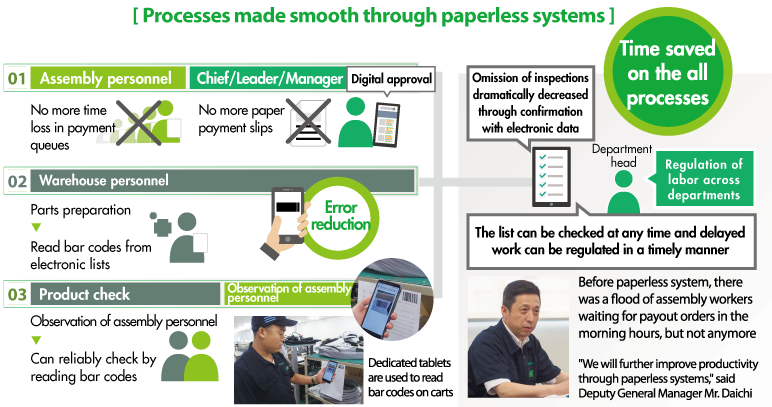

Person in charge of acceptance test working
on a PC display
We switched to a system where the inspection documents in the acceptance test and the production instructions in the power supply assembly are made paperless, and all this work is done on a PC. In the acceptance test, we check whether parts ordered from a local manufacturer comply with the specifications and whether or not there is any damage. In the past, large piles of drawings and documents piled up on desks, and some parts were overlooked during the test because 100, 200 parts were inspected in a narrow work space.
Since June 2018, the company has been paperless, and in about half a year, has successfully reduced these oversights by about 50%. The company has also introduced the latest calipers, which can automatically input measurements into PCs, and has achieved a significant reduction in mistakes and labor costs together with paperless system. Similar results have been obtained in the power supply assembly line, and further improvements are planned by expanding paperless system for the production instructions to other processes in the future.
Manpower reduction and labor saving through introduction of multi-axis robots and automatic conveyor machines
Automation is another initiative that is working towards 24-hour automation of the parts cutting process by multi-axis robots and automatic loading of plate materials for laser processing. Optimizing the number of staff to be placed in both can contribute to the improvement of productivity.
After over a year of preparation, an automatic transport system was introduced to the sheet metal process in November 2018. Equipped with racks that can stock 12 different thicknesses of plate material. Plate material is taken out from the rack, held by an air sucker and carried to the laser machine. In the conventional laser machining process, three people were required; when carrying heavy materials, six people were required, but when the automatic transport device is in operation, only two people are required at all times. Also, while three shifts are currently required, unmanned operation at night will also be possible after the end of the day.
Deputy General Manager Daichi said, "Handling plate materials being dangerous work, the burden on workers was huge because of the physical strength required. This is an effective investment if we consider the safety aspect and the reduction of burden on the staff," estimating the effects of introduction. The investment is expected to be recovered within 1 year of operation.

An automatic transport machine that can stack 12 different thicknesses of plate material
Reducing claims during delivery by creating a site to comply with the procedure manual
The factory strength is great to achieve a nearly double production increase in several years. As General Manager Tsuchiya says, "Awareness of improvements has been continuous since the start of the factory, and now the staff is thinking for themselves in order to achieve the monthly production target,". There are a number of noticeable improvements and ingenuities that make use of staff ideas such as walking all over the site, jigs that stabilize parts that would otherwise roll if not supported by hand, mobile racks where parts can be lined up from the production side and moved over to the next process and work benches dedicated to assembling the wire harnesses without mistakes. At the Amoy Plant, Sodick’s unique "QVP+ (Quality Victory Plan Plus)" activities are also promoted, where each employee works to improve the quality of their work with a goal. There is also a spot to announce the results of activities, which is a great opportunity to motivate the staff.
On the other hand, the rapid increase in production volume caused problems. Until then, instead of focusing on the priority points for inspections in each process, quality was ensured through thorough inspections by the Japanese staff, but the increased production made this difficult. Therefore, inspections for each process are enhanced and work standardization is promoted at the same time. In order to maintain the same quality regardless of "who" or "when," we've worked on the maintenance of procedure documents and the building of "sites where procedures are followed."
As part of this, "quality patrols" started in early 2015. This is an activity where QA headquarters staff walk around the site, checking how well the procedures are followed. General Manager Nobuyoshi Nabekura recalled, "It was unknown how many people were following the procedures, but when I checked, the number of violations I found exceeded my expectations."
When we looked for causes of these violations, we found not only that the procedures were not followed, but that in some cases there were problems with the procedures themselves. Therefore, specialty staff is stationed in each department, and the procedures are intensively prepared over three months. The maintenance of procedure documents led to a significant reduction in the violation rate since 2017.

Chinese staff listening to explanations from a Japanese engineer
Expanding past efforts horizontally to speed up the pace of growth
The aim of the Amoy Plant is "a factory which is unsurpassed in quality and productivity among Sodick’s five factories" (General Manager Tsuchiya). How can quality metrics reduce the number of claims from customers? Therefore, with the QA division as the center, together with conventional quality patrols, FMEA (Failure Mode Effect Analysis) was launched. As part of this, we have started a new prevention initiative which involves asking on-site staff to point out "near misses," which are likely to be a factor in claims. About 15 cases were pointed out in a month, leading to a review of the work procedures. Also, by expanding paperless systems to other processes, we aim to further increase productivity.
Through eleven years of operation, the technical skill level of the Chinese staff has steadily increased. At the Amoy Plant, the time it takes to train new employees was shortened by visualizing the skills required at each site and clarifying what the training staff should teach. We also focus on technical guidance to teach the know-how of Japanese engineers to the Chinese staff, to cultivate highly skilled young staff.
Paperless systems and automation approached the level that General Manager Tsuchiya thought "should be an example for the other factories." We also created on-site capabilities to support challenging initiatives. We are establishing the foundation of an important production base for expanding the share in global market.






